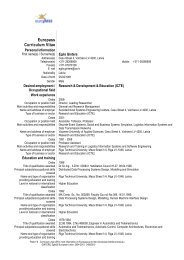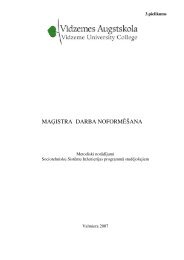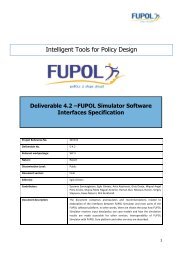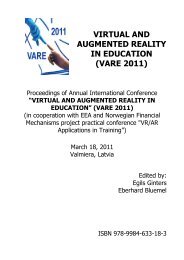Proceedings in pdf format. - Sociotechnical Systems Engineering ...
Proceedings in pdf format. - Sociotechnical Systems Engineering ...
Proceedings in pdf format. - Sociotechnical Systems Engineering ...
You also want an ePaper? Increase the reach of your titles
YUMPU automatically turns print PDFs into web optimized ePapers that Google loves.
Depend<strong>in</strong>g on the outcomes of the diagnosis processthe coached person is guided on either a knowledgeorientedor rather a problem-oriented path of learn<strong>in</strong>gmodules match<strong>in</strong>g with his/her learn<strong>in</strong>g context and level(see Figure 2). As shown <strong>in</strong> Figure 1, a knowledgeorientedpath (A) focuses on a particular aspect or subjectarea of ECR and allows ga<strong>in</strong><strong>in</strong>g relatively wide-areaknowledge <strong>in</strong> this field (but perhaps at vary<strong>in</strong>g levels ofdetail). Follow<strong>in</strong>g such a path also helps to answerquestions like:• Which are the problems this particular knowledge isrelevant for?• If I go through those modules which k<strong>in</strong>d ofproblems I can better deal with afterwards?This way, any knowledge-oriented path alsocontributes to strengthen problem-solv<strong>in</strong>g competencerelated to the implementation of ECR <strong>in</strong> a supply cha<strong>in</strong>.In difference to this a problem-oriented path (B) clearlyaims at develop<strong>in</strong>g much more specific problem-solv<strong>in</strong>gcompetence by provid<strong>in</strong>g <strong>in</strong>structions and methodicalknowledge on how to solve a particular problem. Itespecially helps to answer questions like:• Knowledge from which fields might be of help tosolve my particular problem?• In which directions I might th<strong>in</strong>k to f<strong>in</strong>d a solution tomy particular problem?In the end, those modules which might belong to aparticular path correspond<strong>in</strong>g to the <strong>in</strong>dividual needs areidentified each of them deal<strong>in</strong>g with certa<strong>in</strong> aspects ofunderstand<strong>in</strong>g and implement<strong>in</strong>g Efficient ConsumerResponse <strong>in</strong> supply cha<strong>in</strong>s. Step (C) <strong>in</strong> the diagnosisprocess then decides about what a user should berecommended:BWhat isyour problem?Problem specificationcheck listProblem-oriented oriented Learn<strong>in</strong>g PathAKnowledge-orientedorientedLearn<strong>in</strong>g PathECRShr<strong>in</strong>kageRFID Technology……CWhat is…How to DesignRFID TechnologyHow to Run a SCby Use of RFIDHow to ApplyRFID <strong>in</strong> SCsHow to ImproveData AccuracyHow to Deal withExcessive StocksHow to ReduceLong Lead TimesHow to AvoidOut of StocksHow to ReduceShr<strong>in</strong>kage…Figure 2. How the ECR e-coach works.• Am I able to solve a respective problem related tothe identified aspect of ECR? => If so, we, forexample, might propose to go for exam<strong>in</strong>ation ofknowledge or certification of competence;• Do I need to know more about this particular aspectof ECR? => If so, we would <strong>in</strong>itiate a learn<strong>in</strong>gprocess and propose a learn<strong>in</strong>g path for this, which isoffered and guided-on-demand by the e-coach’slearn<strong>in</strong>g environment.The learn<strong>in</strong>g environment of the ECR e-coach isformed by a learn<strong>in</strong>g management system with a numberof modules as well as a wide range of <strong>in</strong><strong>format</strong>ion andcommunication tools embedded <strong>in</strong> it. To ensurefunctionality as described above the modules belong tothe follow<strong>in</strong>g ma<strong>in</strong> categories:• Description-oriented modules deliver knowledge ona specific aspect of ECR such as shr<strong>in</strong>kage or RFIDtechnology (What is …?);• Problem-based modules provide relevant knowledgefor identify<strong>in</strong>g, specify<strong>in</strong>g and solv<strong>in</strong>g a particularproblem, like shr<strong>in</strong>kage reduction or application ofRFID technology <strong>in</strong> supply cha<strong>in</strong>s (How to …?);Annual <strong>Proceed<strong>in</strong>gs</strong> of Vidzeme University College “ICTE <strong>in</strong> Regional Development”, 200664









